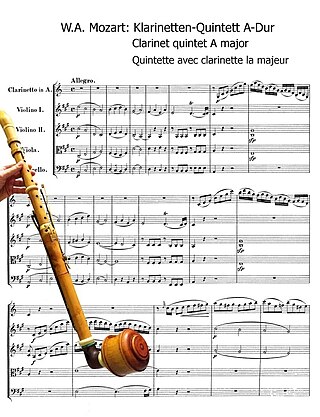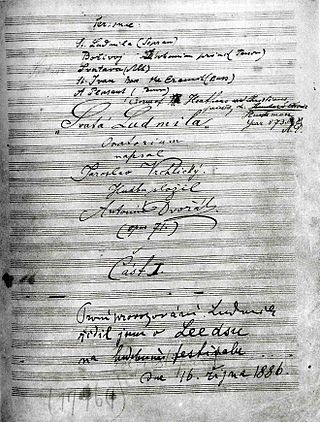Ludwig van Beethoven's Cantata on the Death of Emperor Joseph II, WoO 87 is a cantata with a libretto by Severin Anton Averdonk (1768-1817), written in 1790 and intended for a memorial service for Joseph II, Holy Roman Emperor to be held in Bonn. Composed when Beethoven was nineteen, it was neither published, nor apparently performed until it premiered in Vienna in November 1884, fifty-seven years after Beethoven's death, and it was first printed in an 1888 supplement to the Complete Works. It remains one of Beethoven's lesser-known works.
The cantata, written in C minor, has seven movements.
The work is scored for 2 flutes, 2 oboes, 2 clarinets, 2 bassoons, 2 horns, strings and SATB chorus with solo soprano and bass (there is also a solo semichorus SSATB). The seven movements take approximately 35 minutes to perform.

The Violin Concerto in D major, Op. 61, was written by Ludwig van Beethoven in 1806. Its first performance by Franz Clement was unsuccessful and for some decades the work languished in obscurity, until revived in 1844 by the then 12-year-old violinist Joseph Joachim with the orchestra of the London Philharmonic Society conducted by Felix Mendelssohn. Joachim would later claim it to be the "greatest" German violin concerto. Since then it has become one of the best-known and regularly performed violin concertos.

The Symphony No. 2 in D major, Op. 36, is a symphony in four movements written by Ludwig van Beethoven between 1801 and 1802. The work is dedicated to Karl Alois, Prince Lichnowsky.

Die Schuldigkeit des ersten Gebots, K. 35, is a sacred musical play composed by Wolfgang Amadeus Mozart in 1767 when he was 11 years old. It is Mozart's first opera or, more specifically, sacred drama, as is suggested by the name. The libretto is now attributed to Ignatz Anton von Weiser, although Johann Adam Wieland or Jakob Anton Marianus Wimmer had been suggested earlier. Only the first part of the opera was composed by Mozart; the second and third parts were contributed by Michael Haydn and Anton Cajetan Adlgasser respectively. However, these other two parts have not survived. Part 1 of the opera was first performed on March 12, 1767, in the Knight's Hall of the Palace of the Archbishop, the Salzburg Residenz. Part 2 was performed on March 19, and part 3 on March 26.

Ludwig van Beethoven's Piano Concerto No. 1 in C major, Op. 15, was written in 1795, then revised in 1800. It was possibly first performed by Beethoven at his first public concert in Vienna on 29 March 1795. It was first published in 1801 in Vienna with dedication to his pupil Princess Anna Louise Barbara Odescalchi, known to her friends as "Babette".

L'estro armonico, Op. 3, is a set of 12 concertos for string instruments by Italian composer Antonio Vivaldi, first published in Amsterdam in 1711. Vivaldi's Twelve Trio Sonatas, Op. 1, and Twelve Violin Sonatas, Op. 2, only contained sonatas, thus L'estro armonico was his first collection of concertos appearing in print. It was also the first time he chose a foreign publisher, Estienne Roger, instead of an Italian. Each concerto was printed in eight parts: four violins, two violas, cello and continuo. The continuo part was printed as a figured bass for violone and harpsichord.

Wolfgang Amadeus Mozart's Clarinet Quintet, K. 581, was written in 1789 for the clarinetist Anton Stadler. A clarinet quintet is a work for one clarinet and a string quartet. Although originally written for basset clarinet, in contemporary performances it is usually played on a clarinet in A. It was Mozart's only completed clarinet quintet, and is one of the earliest and best-known works written especially for the instrument. It remains to this day one of the most admired of the composer's works. The quintet is sometimes referred to as the Stadler Quintet; Mozart so described it in a letter of April 1790. Mozart also wrote a trio for clarinet, viola and piano for Stadler, the so-called Kegelstatt Trio, in 1786.

The cello suites by Benjamin Britten are a series of three compositions for solo cello, dedicated to Mstislav Rostropovich. The suites were the first original solo instrumental music that Britten wrote for and dedicated to Rostropovich, but Britten had earlier composed a cadenza for Joseph Haydn's Cello Concerto in C major, for Rostropovich, in 1964. Rostropovich gave the first performances of each work, and recorded Suites Nos 1 and 2 commercially.

The Violin Sonata No. 7 in C minor by Ludwig van Beethoven, the second of his Op. 30 set, was composed between 1801 and 1802, published in May 1803, and dedicated to Tsar Alexander I of Russia. It has four movements:
The Quintet in E♭ major for Piano and Winds, K. 452, was composed by Wolfgang Amadeus Mozart on March 30, 1784 and premiered two days later at the Imperial and Royal National Court Theater in Vienna. Shortly after the premiere, Mozart wrote to his father that "I myself consider it to be the best thing I have written in my life." It is scored for piano, oboe, clarinet, horn and bassoon.
The six String Quartets, Op. 76, by Joseph Haydn were composed in 1797 or 1798 and dedicated to the Hungarian count Joseph Georg von Erdődy (1754–1824). They form the last complete set of string quartets that Haydn composed. At the time of the commission, Haydn was employed at the court of Prince Nicolaus Esterházy II and was composing the oratorio The Creation as well as Princess Maria Hermenegild Esterházy's annual mass.
An organ concerto is an orchestral piece of music in which a pipe organ soloist is accompanied by an an orchestra, although some works exist with the name "concerto" which are for organ alone.
Ferdinand Ries composed the Symphony No. 5 in D minor, Op. 112, in London in 1813. It was the second symphony Ries wrote. It was first performed at a Philharmonic Society concert on 14 February 1814. In 1823, Breitkopf & Härtel published the work together with piano solo, piano duet and chamber arrangements.

The Symphony No. 7 in C major, Hoboken I/7, is a symphony by Joseph Haydn, sometimes called "Le midi", meaning "The Noon."

Antonín Dvořák composed his oratorio Saint Ludmila for soloists, choir and orchestra, between September 1885 and May 1886. The oratorio was written to a text by the leading Czech poet and writer Jaroslav Vrchlický. Saint Ludmila is Dvořák's third oratorio, and is considered one of his foremost works.
O ewiges Feuer, o Ursprung der Liebe, BWV 34.2 is an incomplete wedding cantata composed by Johann Sebastian Bach, of which only the complete libretto and some parts have survived.

The Twelve Grand Concertos, Op. 6, HWV 319–330, by George Frideric Handel are concerti grossi for a concertino trio of two violins and cello and a ripieno four-part string orchestra with harpsichord continuo. First published by subscription in London by John Walsh in 1739, they became in a second edition two years later Handel's Opus 6. Taking the older concerto da chiesa and concerto da camera of Arcangelo Corelli as models, rather than the later three-movement Venetian concerto of Antonio Vivaldi favoured by Johann Sebastian Bach, they were written to be played during performances of Handel's oratorios and odes. Despite the conventional model, Handel incorporated in the movements the full range of his compositional styles, including trio sonatas, operatic arias, French overtures, Italian sinfonias, airs, fugues, themes and variations and a variety of dances. The concertos were largely composed of new material: they are amongst the finest examples in the genre of baroque concerto grosso.
The Musette, or rather chaconne, in this Concerto, was always in favour with the composer himself, as well as the public; for I well remember that HANDEL frequently introduced it between the parts of his Oratorios, both before and after publication. Indeed no instrumental composition that I have ever heard during the long favour of this, seemed to me more grateful and pleasing, particularly, in subject.
The Weimarer Passion, BWV deest, is a hypothetical Passion oratorio by Johann Sebastian Bach, thought to have possibly been performed on Good Friday 26 March 1717 at Gotha on the basis of a payment of 12 Thaler on 12 April 1717 to "Concert Meister Bachen". It is one of several such lost Passions. Both the text and music are lost, but individual movements from this work could have been reused in latter works such as the Johannes-Passion. At one time, it was thought that the work set chapters 26 and 27 of the Gospel of Matthew to music, with interspersed chorales and arias, but current consensus is that it is possible that the text reflected a synopsis of two or more Gospel texts, as well as the interspersed chorales and arias.
Il Serpente di Bronzo, ZWV 61 is a sacred cantata composed by the Czech composer Jan Dismas Zelenka (1679–1745).

Stabat Mater (P.77) is a musical setting of the Stabat Mater sequence, composed by Giovanni Battista Pergolesi in 1736. Composed in the final weeks of Pergolesi's life, it is scored for soprano and alto soloists, violin I and II, viola and basso continuo.